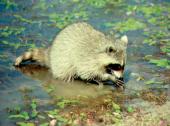
Mammals are one of the group of animals with backbones, known as vertebrates. The members of the class Mammalia are distinguished from the other vertebrate classes by feeding their young by milk from skin glands, breathing with the aid of a muscular diaphragm, having only one bone in the lower jaw, having seven neck vertebra, and possessing three sound-conducting bones in the middle ear. They usually have hair. All of the mammals now found in Saskatchewan are placental mammals, which carry their developing young within the female's body until they are ready for birth, rather than keeping the developing young in a pouch (marsupials) or laying eggs (monotremes). Mammals have the largest and most complex brains of any group of animals, and their complex behaviours reflect this. Mammals gradually evolved from the synapsid Reptiles, beginning in the Triassic (225-195 million years ago).
Mammals have a high body temperature which requires considerable food resources to maintain. Mammals living in areas where there are reductions in food sources due to dry or cold seasons may either migrate and leave the area, or go underground and hibernate. In Saskatchewan, for example, most Bats migrate south during the winter; caribou migrate through the boreal area looking for patches of lichens and vegetation; several types of Rodents hibernate; and the black bear goes into a deep sleep.
Mammals are found over the whole earth, missing only from the centres of ice sheets and the depths of the oceans. Their places in the ecosystems depend on their diets. Some, such as humans and bears, are generalists which can take advantage of a broad variety of foods. Others are more specialized in feeding, such as nectar-feeding bats or blood-feeding vampire bats. There are large numbers of herbivores that take advantage of plant communities. The Carnivores feed on the herbivorous mammals and other plant-feeders. The highest diversity of mammals is found in the wet tropics.
There are seventy-two species of wild mammals presently found in the province, out of approximately 4,400 known in the world. There are representatives of six of the twenty living orders of mammals: Insectivora (Shrews), Chiroptera (bats), Lagomorpha (Hares and Rabbits), Rodentia (rodents), Carnivora (carnivores) and Artiodactyla (deer, Bison, and Pronghorn). There are no species of mammals unique to Saskatchewan. The largest mammal in Saskatchewan is the male American bison, at one ton; the smallest is the pigmy shrew at 2 gr. The affinities of the fauna are mainly with Eurasia (deer, hares, bats, shrews, squirrels, wolves, etc), but some are with South America (raccoon, porcupine). The pronghorn is found only in the Prairies of North America and has no living close relatives. A number of species have come in with settlement; these include, besides domesticated species such as cattle, the horse and the domestic cat, species considered vermin: the house mouse, brown rat, and black rat. Others from eastern Canada, such as the fox squirrel, have taken advantage of habitat changes by humans to travel into the province.
Several species have recently been lost from the fauna, such as the black-footed ferret and the Plains grizzly. A number of other species, particularly the larger carnivores, have been reduced by a combination of hunting for food, furs or sport, and habitat loss due to agricultural development. Some, such as the swift fox and the American bison, have been the focus of successful Conservation efforts to increase their depleted numbers. All wild mammals are protected by the provincial Wildlife Act, which controls their killing: for a number of species of fur-bearers and ungulates there are specified seasons and limits.
Diane Secoy
Print EntryHOME | BROWSE BY SUBJECT | ENTRY LIST (A-Z) | IMAGE INDEX | CONTRIBUTOR INDEX | ABOUT THE ENCYCLOPEDIA | SPONSORS TERMS OF USE | COPYRIGHT © 2006 CANADIAN PLAINS RESEARCH CENTER, UNIVERSITY OF REGINA | POWERED BY MERCURY CMS |
|||
| This web site was produced with financial assistance provided by Western Economic Diversification Canada and the Government of Saskatchewan. |
|||
 |
 |
 |
 |
| Ce site Web a été conçu grâce à l'aide financière de Diversification de l'économie de l'Ouest Canada et le gouvernement de la Saskatchewan. |
|||